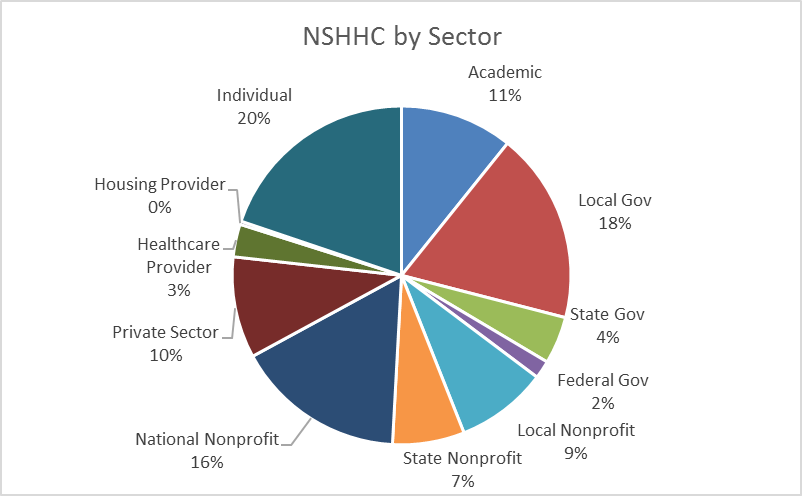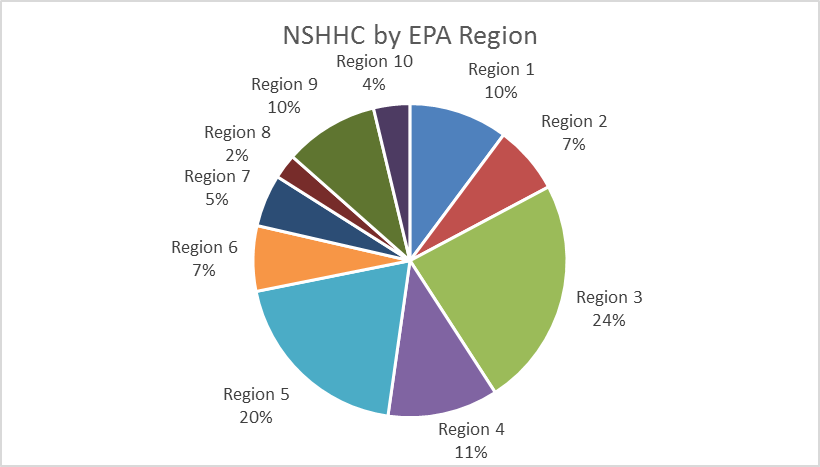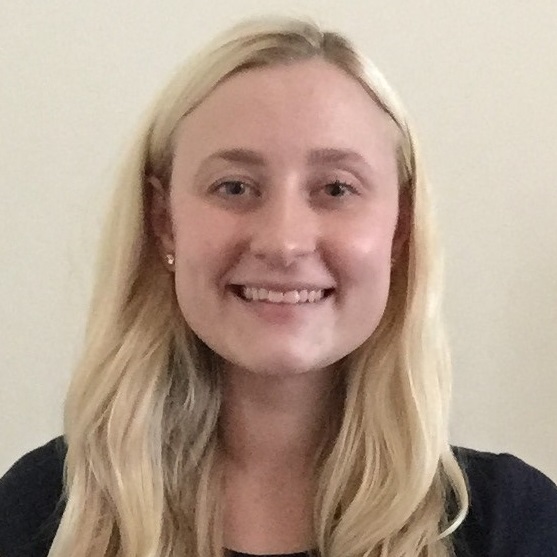Ten Years of the National Safe and Healthy Housing Coalition: Who We Are Now
by Sarah Goodwin, Anna Plankey, and members of the National Safe and Healthy Housing Coalition Steering Committee
This is the third installment in a series celebrating the first 10 years of the National Safe and Healthy Housing Coalition. Read the first installment here and the second installment here.
When we sat down to plan out a blog series celebrating the 10th anniversary of the National Safe and Healthy Housing Coalition, we wanted to make sure we had a space in the plan to step back from the history and accomplishments of the coalition and instead shine a light on what makes this coalition work in the first place: That would be, of course, the dedicated people and organizations who make up the coalition membership.
For most of you, the most visible aspect of the coalition is probably our emailed action alerts, or maybe you’ve looked at the website from time to time. We try to be as visible as we can about our appropriations and policy efforts (in fact, we wrote a whole blog about that!) but what you might not hear about as often are the details of who our coalition actually is: what our membership looks like broken down, the awesome work our members are doing in the field, and how the members of our steering committee shape coalition policy.
Who Are the Coalition Members?
 As you can see in the chart to the right, the NSHHC is a varied bunch. Of our over 600 members where we’ve recorded sectors, about a quarter represent local, state, or federal governments. Of our nongovernmental members, just over 30% represent nonprofits, and another 20% are unaffiliated. Our smallest sector represented is housing providers, with only a couple members.
As you can see in the chart to the right, the NSHHC is a varied bunch. Of our over 600 members where we’ve recorded sectors, about a quarter represent local, state, or federal governments. Of our nongovernmental members, just over 30% represent nonprofits, and another 20% are unaffiliated. Our smallest sector represented is housing providers, with only a couple members.
As you may have heard us announce before, we currently have members from 49 states (the exception being the ever-elusive North Dakotans), DC, Puerto Rico, and Guam. We also have a smattering of members hailing from outside the U.S.
However, our membership does have a distinct regional tilt. Our most populous regions are regions three (the Mid-Atlantic, largely due to the high number of national organizations located in DC and Maryland) and five (the Midwest). Regions from the south and west tend to be underrepresented compared to the U.S. population.
What Are Coalition Members Doing?
To celebrate its 10-year anniversary this summer, NSHHC reached out to its members to highlight the healthy housing work carried out by their organizations across the nation. This State and Local Spotlight Project collected stories that will be featured on our website to acknowledge the variety of ongoing or recently completed efforts in the healthy housing field of the NSHHC membership. Multiple member organizations graciously offered anecdotes on particularly innovative, challenging, or remarkable programs occurring within their communities. This project not only serves to celebrate coalition members’ state and local programs, but also offers insight into best practices, guidance, and methods for future local programs in the healthy housing arena. Some excerpts from coalition member submissions to this State and Local Spotlight project are provided below along with links to the full write-ups, which we encourage you to check out! We’ll post more Spotlight submissions in the coming weeks.
“The Health and Housing Block Party on the Hill was hosted in April of 2019 for the city of Worcester, its residents, the elected representatives of the city, and HUD officials…. The goals of these were to educate the representatives on the healthy housing issues unique to the city, as well as informing the general population about asthma, lead, and other housing concerns…. Over 2,000 of the city residents came to the block party and had the opportunity to get more information about the resources they have available, and what they can do to ensure the health of them and their families. We were able to successfully work with Representative James McGovern, who has endorsed increases in healthy housing funding for HUD as a result. Engagement with state officials has also resulted in $50 million set aside in the state budget for the city, in order to fund repairs to meet the sanitary and building code.”
– Health and Housing Block Party on the Hill, City of Worcester Housing Development and Healthy Homes, Massachusetts
“The Louisiana State University Health School of Public Health conducted a program to highlight the areas of exposure of lead in water and to assist residents in locating the most cost-effective solutions…. Through this project, we were able to provide online information to the public, including resources and treatment recommendations, as well as guidelines for public health officials to assist in serving rural and Spanish-speaking communities…. This project assisted in changing lives by providing education to those that were alerted to the water crisis from the results of Flint, Michigan; throughout the project we have received feedback from members of these communities noting their appreciation for the educational resources to better their living conditions.”
– Louisiana State University Health, Louisiana
“Our Home Repair Program targets the disrepair in housing that can have a poor impact on the health for residents. This highlighted Home Repair Program in Mrs. S’s home provided direct service repairs of mold removal, roof demolition, and roof repair…. Due to the critical repairs from Rebuild Upstate’s Home Repair Program and Mrs. S’s decision to quit smoking seven years ago, she hasn’t been to the emergency room in four years. Instead of making her sick because of mold exposure, her home now compliments her health choices, has kept the family within the home, and has reduced energy and healthcare bills.”
– Home Repair Program, Rebuild Upstate, South Carolina
Who Is the Steering Committee?
The NSHHC is governed by a 12-16 person steering committee. Membership is voluntary, approved by a vote of coalition members, and terms last for two years. The steering committee is required to have at least one local government organization and one local community-based organization included as members.
We last elected our steering committee in the spring of 2018, so another election will come up next year! Stay tuned over the coming months for information on how to nominate candidates and vote. Our current steering committee includes the following members:
- Alameda County Healthy Homes Division
- Asthma and Allergy Foundation of America
- Boston Public Health Commission
- Childhood Lead Action Project
- Green & Healthy Homes Initiative
- Lead and Environmental Hazards Association
- Marion Public Health
- Metropolitan Tenants Organization
- National Association for State Community Services Programs
- National Center for Healthy Housing (Co-Chair)
- Omaha Healthy Kids Alliance ·
- Public Citizens for Children and Youth ·
- Rodin Center for Social Justice, Loyola University Chicago ·
- Rural LISC ·
- Tribal Healthy Homes Network (Co-Chair)
The steering committee meets quarterly to determine coalition policy items, like our annual appropriation asks, as well as lay out coalition content, including webinar topics and strategic planning development.
Short Takes from Steering Committee Members
To help members get to know the steering committee a little better, we asked steering committee members to share some thoughts on why they joined the committee and how they interact with and benefit from the NSHHC.
Public Citizens for Children and Youth, Philadelphia, PA
I’ve relied on the expertise and guidance of National Center for Healthy Housing staff for over 15 years as a child advocate at Public Citizens for Children and Youth (PCCY) in the Philadelphia area. I don’t know how long I’ve been a part of the National Safe and Healthy Housing Coalition, but over the years coalition members from across the country have also been instrumental to my lead poisoning prevention work by not only sharing best practices but also lessons learned, so we avoid some of the barriers they’ve encountered. That’s how we advance policy for kids and families by understanding what’s successful in other places and replicating those practices to fit our local needs. I am grateful for coalition members’ perseverance, dedication, and willingness to share, so a year ago I joined the NSHHC’s steering committee to help give back for the help I’ve gotten and continue to build my leadership skills.
Most recently over the last two years, PCCY’s Lead Free Philly Coalition has been steadfastly engaged in strengthening the city’s 2011 pre-rental lead law, and coalition members from Maryland, Rochester, New York City, Massachusetts, and DC have generously shared their time and experiences to help us make our case for change. We’ve been inspired by the tenacity of California advocates as they fought for more than a decade and successfully sued the paint companies who sold their dangerous, leaded-paint products, so we consulted with some of them and helped launch a suit here in Pennsylvania! Like good coalitions do, they connect people and build solidarity and momentum for positive change, and I appreciate that connection from members of the NSHHC.
– Colleen McCauley, Health Policy Director
Marion Public Health, Marion, OH
Joining the National Safe and Healthy Housing Coalition (NSHHC) steering committee has made me a more diverse and well-rounded housing professional. By participating in the coalition, I have incorporated many ideas and programmatic changes from other coalition members and webinars from the NSHHC.
The NSHHC was invaluable this past year when my health department participated in public health advocacy. A NCHH staff member made sure I was prepared to talk to my state senator’s office and house of representative’s office. NCHH provided a fact sheet with current data that were used as talking points which started a great conversation. I would not have been able to effectively advocate for public health without the NSHHC.
– Tyler Pigman, Environmental Health Director
Boston Public Health Commission, Boston, MA
The Boston Public Health Commission joined the National Safe and Healthy Housing Coalition (NSHHC) because our missions are closely aligned. Both organizations strongly believe that healthy and stable housing promote good health and well-being, and support equitable access to safe, healthy, stable, and affordable housing for everyone. Being a member of the NSHHC has been very beneficial and important for our organization, because it provides a unique opportunity to share best practices and learn about replicable healthy housing models that can be adopted in our community and improve our efforts. In addition, being a coalition member, we have access to wealthy information, education, training, and resources that we need to support our healthy housing work.
We are proud of the NSHHC’s policy advocacy efforts to restore and increase federal funding for lead, asthma, and healthy homes throughout the years to support healthy housing in United States. We are particularly proud of the coalition’s part in launching the “Find It, Fix It, Fund It” campaign to eliminate lead. This national comprehensive initiative is a great example of the NSHHC’s commitment and dedication to address lead poisoning and build support for public funding and policies to improve housing for low-income and most vulnerable populations in the United States.
– Eugene Barros, Division Director of Healthy Homes and Community Support
 Sarah Goodwin joined NCHH as a policy analyst in June 2017. She previously served NCHH as a policy intern, helping to establish and run the Find It, Fix It, Fund It lead action drive and its work groups. She holds a Bachelor of Arts degree in Interdisciplinary Studies: Communications, Legal Institutions, Economics, and Government from American University.
Sarah Goodwin joined NCHH as a policy analyst in June 2017. She previously served NCHH as a policy intern, helping to establish and run the Find It, Fix It, Fund It lead action drive and its work groups. She holds a Bachelor of Arts degree in Interdisciplinary Studies: Communications, Legal Institutions, Economics, and Government from American University.
 Anna Plankey, Junior Analyst, joined the National Center for Healthy Housing in 2019. Initially serving as a policy intern, she aided in the coordination of the National Safe and Healthy Housing Coalition’s Hill Day in February 2019 in conjunction with the Lead Poisoning Prevention and Healthy Housing Conference in Washington, DC. She holds a Bachelor of Arts degree in History of Public Policy from University of California, Santa Barbara.
Anna Plankey, Junior Analyst, joined the National Center for Healthy Housing in 2019. Initially serving as a policy intern, she aided in the coordination of the National Safe and Healthy Housing Coalition’s Hill Day in February 2019 in conjunction with the Lead Poisoning Prevention and Healthy Housing Conference in Washington, DC. She holds a Bachelor of Arts degree in History of Public Policy from University of California, Santa Barbara.
